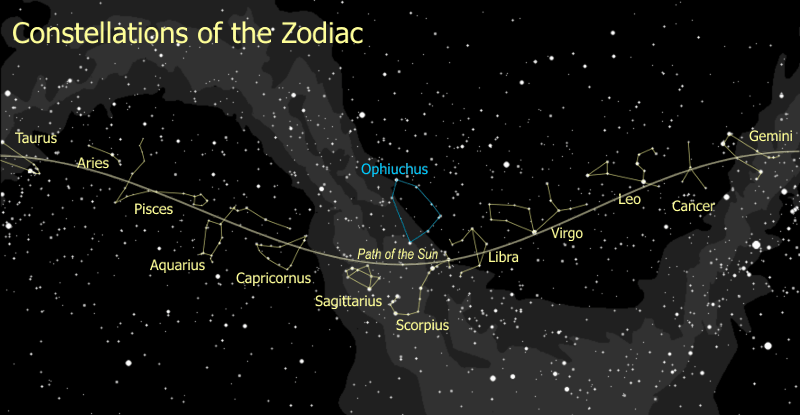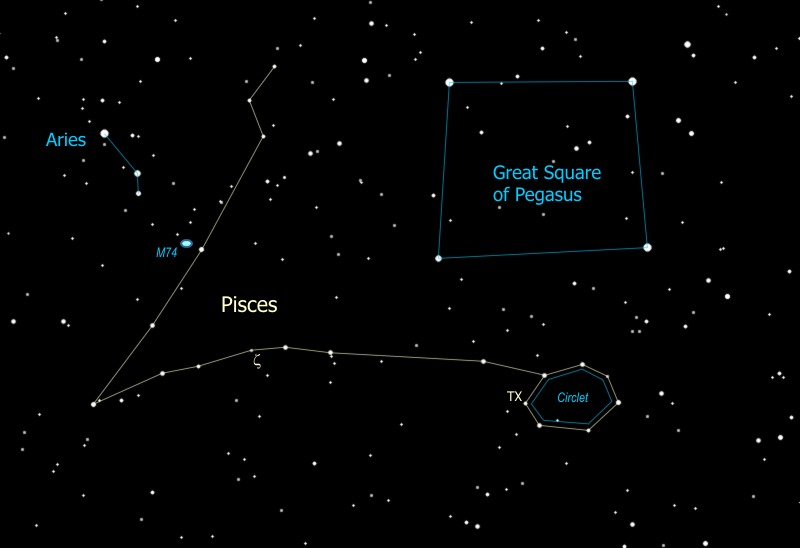Stargazing

|
The Zodiac Constellations |

|
- Well, we've hit the horizon and run out of Milky Way so we'll hang a left
and head south along the horizon, which brings us to the Zodiac constellation
Capricornus. This is a faint constellation, you have to look hard to see
it. In rough terms it's an upside-down triangle, curved a little bit so it
starts to resemble a big smile. {Trace out Capricornus} Unfortunately it
isn't called Capricornus the Big Smile, it's called Capricornus the Goat.
Well actually, a goat with a fish tail. See it?
Nah, me neither. But here's what you can see, if you look hard at the brightest star of the (not too bright) constellation, at the upper right (Northwest) corner, α Capricorni, also called Giedi Prime. For you Dune fans, yes, that's where the bad guys live. But look at it... is that one star or two? What do you think? That's right, it's two -- hey hey hey, that's cheating, looking in the binoculars! They aren't related to each other, the dimmer one to the right is about five times farther away than the brighter one to the left, but it turns out each one is itself a true double. Ah - so no wonder it's the brightest star in Capricornus - it's four stars.

- I called Capricornus a Zodiac constellation. What is a
"Zodiac" constellation? (I have been surprised to
discover that few, if any, kids can answer this question.)
As the earth goes around the sun, this motion means that every day we look back at the sun in a slightly different direction, with different stars behind it. The sun appears to move through the constellations. Theoretically there are twelve constellations through which the sun moves, one per month, and these are the Zodiac constellations. In reality there is a 13th constellation through which the sun passes (technically, at least) and it gets no credit for being in the Zodiac - Ophiuchus.

- Now directly above Capricornus, and below the Great
Square of Pegasus, we have the next of the Zodiac constellations, Aquarius.
Yes, this is THE Aquarius, as in the Age of Aquarius in the song.
Aquarius is just as faint as Capricornus, and it's an odd constellation
that wanders around the sky. As a result, it's best to find it piece by
piece.
Aquarius is a water carrier, pouring his pitcher of water into a standing urn. We start with the figure of Aquarius, which is a straight line, which begins just above Capricornus {I'm pointing to ε} and angles up and to the left {drawing a line to β then to α}. His water jar is the "Y" shaped figure of stars next to α Aquarii, and is probably the easiest part of the constellation to identify. The urn is then right below it {trace out the urn}, complete with little feet holding it up.
Remarkably, the third bright star down on the right side of the urn, δ Aquarii, is a member of the Ursa Major Moving Group! That's a pretty big "open cluster".
- Just below Aquarius you can see a lone bright star
in the sky, a first magnitude star by the name of Fomalhaut (pronounced
like "foam a lot"). This is the eye of the Southern Fish, Piscis Austrinus.
Just below Fomalhaut is a pair of stars forming the mouth of the fish, and
the remaining stars trace out the body of the fish quite nicely {Trace out
Piscis Austrinus} He even has a little fishy-fin. Fomalhaut is easily
recognized since it is the one bright star to the south in the fall. It
is also part of a constellation that looks just like what it is supposed
to be.
- Piscis Austrinus is not a Zodiac constellation, but the
next Zodiac constellation is also a fish, in fact it's two fishes, known
as Pisces. This is another really faint one, and we will start on it
with a faint but distinctive asterism known as the Circlet, just below the
Great Square of Pegasus, a little circle (or more accurately, an oval)
of stars that represent one of the fishes. The rest is tricky, as it
represents a cord that ties this fish to the second. The cord forms a
"V" shape, with our Circlet at one tip of the V and the other fish,
represented by just three stars, at the other tip. {Trace out Pisces}

Two stars of note in Pisces are ζ (zeta) Piscium, and another star with the peculiar designation of "TX". To appreciate ζ we will get it in the telescope, where you can see it is a very nice binary star - a white star with a fainter yellow companion to the northeast. Meanwhile TX, the leftmost (eastern-most) star of the circlet, is just a red star -- a really, really red star. This star is a "carbon star" - it has been red giant a long time, burning the helium ash from the burned-up hydrogen and producing carbon. That means this is a very old, and very red, red giant star.
- If you're going for the Astronomy merit badge you need four Zodiac constellations
and it just so happens you're in luck... we've got one more, this time going
west from Taurus. So this is on the sun's path before it reaches Taurus;
just to the west of the Pleiades you find the constellation Aries the Ram. The
easiest part of the constellation to spot is a set of three bright stars forming
a bent line or a very flat triangle. {Point out the central stars in Aries.}
Most star charts only show these three stars. However, if you follow the line
of the whole constellation you get a much better sense of the ram's horns.
{Trace out the full constellation.}

- The little bitty triangle buzzing around to the left of the bright central
stars of Aries used to be a constellation of its own, called the Northern
Fly. {Point out the Northern Fly.} Mercifully the fly was gassed and now
those stars are officially part of Aries. (There is a Southern Fly - since
the demise of Northern Fly the Southern Fly is just the Fly - near the
Southern Cross close to the South Pole. We can't see it.)
- Just to the north of Aries you might notice a distinct, narrow triangle of stars,
which happens to be another constellation whose name is, surprisingly enough,
Triangulum. {Trace out Triangulum}
- Aside from being a neat looking constellation, Triangulum is the home of another
galaxy, M33. This galaxy is just a little farther from us than the Andromeda
galaxy, about 2.4 million light years away, and belongs to our group of galaxies
- astronomers refer to this as the "Local Group".
M33 has a reputation for being tough to see and we need a clear, dark sky to really be able to see it. {Point out M33's location} It is so big, faint, and spread out, that it is actually easier to see in binoculars (if we can see it at all) than in a telescope. On a very dark night you might even be able to see it with your eyes alone, by looking just to one side of it (averted vision).
- The three bright stars of Aries are α (alpha),
β (beta), and γ (gamma).
If we get the telescope on γ, you can see that it is
also a binary, a close pair of clear white stars. If you don't want to bother
with the telescope you can spot another double with the binoculars -- mid-way
and slightly above the line between α and β is λ Arietis, a bright yellow
star with a faint yellow companion, just above it. You can spot the faint twin
with 10x50 binoculars - if you hold them rock steady. Both of these double
stars, γ and λ, are true
binary systems -- twin stars that were formed together and are now orbiting one
another.
 |
 |
 |
| Back to Milky Way | Autumn Index | On to Andromeda |
Questions
Your questions and comments regarding the Stargazing section are welcome.
You can e-mail the author, Randy Culp for inquiries,
suggestions, new ideas or just to chat.
Updated 09 August 2020
